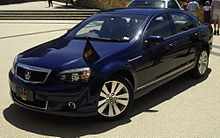
The governor of Victoria is the representative of the monarch, currently King Charles III, in the Australian state of Victoria. The governor is one of seven viceregal representatives in the country, analogous to the governors of the other states and the governor-general federally.

The Union Jack, or Union Flag, is the de facto national flag of the United Kingdom. Although no law has been passed making the Union Flag the official national flag of the United Kingdom, it has effectively become such through precedent. It is the national flag of all British overseas territories, being localities within the British state. The Union Flag was also used as the official flag of several British colonies and dominions before they adopted their own national flags. The flag continues to have official status in Canada, by parliamentary resolution, where it is known as the Royal Union Flag.
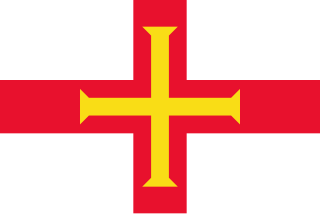
The flag of Guernsey was adopted in 1985 and consists of the red Saint George's Cross with an additional gold Norman cross within it. The creation was prompted by confusion at international sporting events over competitors from Guernsey and England using the same flag. It was designed by the Guernsey Flag Investigation Committee led by Deputy Bailiff Sir Graham Dorey. The flag was first unveiled on the island on 15 February 1985. The gold cross represents William the Bastard, Duke of Normandy. William purportedly was given such a cross by Pope Alexander II and flew it on his standard in the Battle of Hastings. Since 2000, a red ensign with the cross in the fly has been used as the government's civil ensign and as a blue ensign.

The royal coat of arms of the United Kingdom is the arms of dominion of the British monarch, currently King Charles III. Variants of the royal arms are used by other members of the British royal family, by the Government of the United Kingdom, and some courts and legislatures in a number of Commonwealth realms.
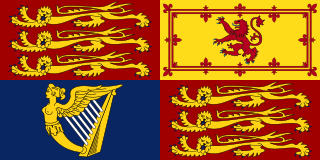
The Royal Standards of the United Kingdom presently refer to either of two similar flags used by King Charles III in his capacity as Sovereign of the United Kingdom, the Crown dependencies, and the British Overseas Territories. Two versions of the flag exist, one for use within Scotland and the other for use elsewhere.

The coat of arms of Australia, officially called the Commonwealth Coat of Arms, is the formal symbol of the Commonwealth of Australia. A shield, depicting symbols of Australia's six states, is held up by native Australian animals, the kangaroo and the emu. The seven-pointed Commonwealth Star surmounting the crest also represents the states and territories, while the national floral emblem appears below the shield.

The royal standards of Canada are a set of uniquely Canadian personal flags used by members of the Canadian royal family. They are used to denote the presence of the bearer within any car, ship, airplane, building, or area, within Canada or when representing Canada abroad. The current flag for the Canadian monarch was unveiled on 6 May 2023, the day of King Charles III's coronation.
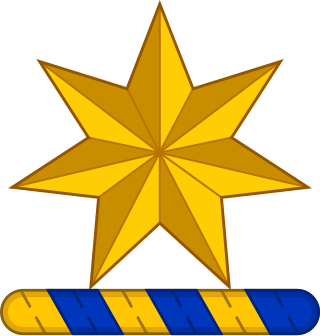
The Commonwealth Star is a seven-pointed star symbolising the Federation of Australia which came into force on 1 January 1901.

The flag of Victoria is a British Blue Ensign defaced by the state badge of Victoria in the fly. The badge is the Southern Cross surmounted by an imperial crown, which is currently the St Edward's Crown. The stars of the Southern Cross are white and range from five to eight points with each star having one point pointing to the top of the flag. The flag dates from 1870, with minor variations, the last of which was in 1953. It is the only Australian state flag not to feature the state badge on a round disc.

The coat of arms of Victoria is the official heraldic symbol of the Australian state of Victoria. Victoria was the second state of Australia to gain arms, granted on 6 June 1910 by royal warrant of King George V. The state had been named in 1851 after his grandmother, who was in reign at the time. The final version of the arms was granted 28 March 1978 in the royal warrant issued by Queen Elizabeth II.
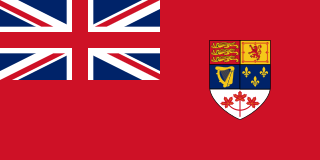
The Canadian Red Ensign served as a nautical flag and civil ensign for Canada from 1892 to 1965, and later as the de facto flag of Canada before 1965. The flag is a British Red Ensign, with the Royal Union Flag in the canton, adorned with the shield of the coat of arms of Canada.

The flag of the governor general of Canada is a flag used as a symbol to mark the presence of the governor general of Canada. Such a flag has been used by governors general since just after Canadian Confederation and the design has altered over decades. The current flag was adopted in 1981.

The Royal Standard Flag of Australia was the personal flag of Elizabeth II in her role as Queen of Australia. It was used in a similar way as the Royal Standard in the UK, signaling the Australian Monarch's presence in Australia, in this case.
As the viceregal representative of the monarch of Canada, the lieutenant governors of the Canadian provinces have since Confederation been entitled to and have used a personal standard. Within a lieutenant governor's province, this standard has precedence over any other flag, including the national one, though it comes secondary to the Queen's Canadian Royal Standard. The provincial viceregal flags are also subordinate to the governor general's personal standard, save for when the governor general is present as a guest of the lieutenant governor.

The flag of Australia, also known as the Australian Blue Ensign, is based on the British Blue Ensign—a blue field with the Union Jack in the upper hoist quarter—augmented with a large white seven-pointed star and a representation of the Southern Cross constellation, made up of five white stars. Australia also has a number of other official flags representing its people and core functions of government.
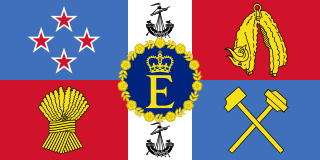
The Queen's Personal New Zealand Flag was the personal flag of Queen Elizabeth II in her role as Queen of New Zealand. It was approved for use in 1962, and was used by the Queen when she was in New Zealand. The Queen’s Representative, the Governor-General of New Zealand, used a separate flag.

The flag of the governor-general of New Zealand is an official flag of New Zealand and is flown continuously on buildings and other locations when a governor-general is present. The flag in its present form was adopted in 2008 and is a blue field with the shield of the New Zealand coat of arms royally crowned. The official heraldic description is "A flag of a blue field thereon the Arms of New Zealand ensigned by the Royal Crown all proper".

The Star of India refers to a group of flags used during the period of the British Raj in the Indian subcontinent. India had a range of flags for different purposes during its existence. The Princely states had their own flags which were to be flown alongside the British flag as a symbol of suzerainty. The official state flag for use on land was the Union Flag of the United Kingdom and it was this flag that was lowered on Independence Day in 1947. The flag of the governor-general of India was defaced with the Star of India. The civil ensign and naval ensign were the Red Ensign or Blue Ensign, respectively, defaced with the Star of India emblem.
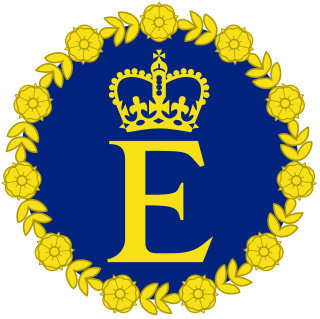
Queen Elizabeth II had a variety of flags to represent her personally and as head of state of several independent nations around the world. They were usually used on any building, ship, car, or aircraft where she was present.

The Tudor Crown, also known as the Imperial Crown, is a widely used symbol in heraldry of the United Kingdom. In use officially from 1902 to 1953 and again from 2022, it represents both the British monarch personally and "the Crown", meaning the sovereign source of governmental authority. As such, it appears on numerous official emblems in the United Kingdom, British Empire and Commonwealth.

